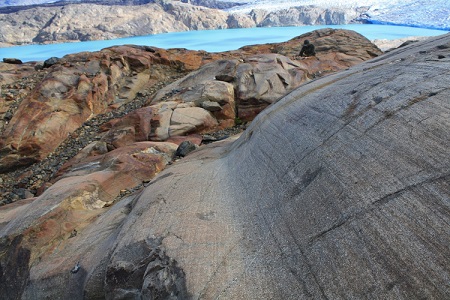
Glacial striations seen near Upsala Glacier, Argentina, where scientists collected glacial samples. This physical scraping produces sediments and dust that can fertilize plankton when it is delivered to the ocean. (Photo by Michael Kaplan/Lamont-Doherty Earth Observatory)
A research team from Columbia University indicates that diatoms, photosynthetic marine organisms responsible for as much as 20% of photosynthesis in the world’s oceans, can directly uptake iron from insoluble iron sediments, and thereby potentially affect atmospheric carbon dioxide level. Although iron is often present in the ocean, usually there is insufficient iron for diatoms and other organisms to grow quickly unless this iron is dissolved and in a form that can be used readily. This research establishes that iron from mineral phases can be quite bioavailable, and that the diatoms can use most forms of iron, but appear to have a preference for a specific form of iron, ferrous iron, in the mineral phases. This research is applicable to a wide variety of questions in earth and ocean sciences, including basic biology of nutrient acquisition, the coupling of physical and geological processes such as glaciers to climate and geoengineering.
The researchers used a wide range of glacial and nonglacial sediment samples from South America that are likely sources of particulate dust, and thus particulate iron, to the Southern Ocean, a region around Antarctica that is particularly deficient in iron. The chemical form in these distinct sediment sources varied considerably, and diatoms ability to grow with these solid sediments varied considerably with both iron concentration and speciation (oxidation state and mineralogy). The chemical speciation and mineralogy of iron in these sediments was determined using x-ray absorption spectroscopy at the Stanford Synchrotron Radiation Lightsource. Glacial sediments rich in ferrous iron sustained more rapid growth, and produced, larger, healthier diatoms than did nonglacial sediments that contained primarily ferric iron oxides. Although ferrous iron is more soluble, the solid did not need to dissolve for growth to occur, but the solid required direct contact between the diatom and mineral substrate. Recent advances in the understanding of diatom physiology and genetics suggest that they have a series of membrane bound proteins that are regulated by the availability of iron that interact with the minerals directly.
This study, performed by Elizabeth Shoenfelt and her advisor, Professor Benjamin Bostick and colleagues supports the notion that climate changes that affect the extent of glaciers can affect marine productivity and climate in unforeseen ways. This study found that glacial processes that create sediments with more reactive iron could be important in fertilizing the ocean in glacial periods, and in doing so, help to decrease carbon dioxide levels in the atmosphere. This idea has existed as a potential means of fighting climate change, but has proven ineffective under most conditions. This research suggests that much more attention should be paid to the chemical form of nutrient iron in the ocean to properly understand future carbon dioxide levels, or to geoengineering solutions to those carbon dioxide emissions.
E. M. Shoenfelt, J. Sun, G. Winckler, M. R. Kaplan, A. L. Borunda, K. R. Farrell, P. I. Moreno, D. M. Gaiero, C. Recasens, R. N. Sambrotto and B. C. Bostick, "High Particulate Iron(II) Content in Glacially Sourced Dusts Enhances Productivity of a Model Diatom", Sci. Adv. 3, e1700314 (2017) doi: 10.1126/sciadv.1700314




